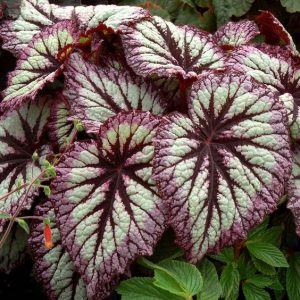Begonia Fireworks

- Botanical Name: Begonia × Fireworks
- Family Name: Begoniaceae
- Stems: 6-14 inches
- Temperature: 15°C -24°C
- Other: indirect light with moderate water and warmth
Overview
Product Description
Begonia Fireworks: A Spectacle of Hues
Theatrical Origins and Charismatic Features
Imagine a botanical firework – that’s Begonia Fireworks. This cultivar of the begonia family is a perennial evergreen that lights up the garden with its explosive display of colors. Its large, dramatic leaves are edged in pink, harbor dark purple centers, and boast a silvery-green band, all wrapped on stems covered in pinkish-red hairs.

Begonia Fireworks
Chromatic Leaves and Their Magical Shifts
The visual feast of Begonia Fireworks lies in its foliage, where colors perform a light-driven dance. Under the stage lights of indirect brightness, the colors put on their most spectacular show. Like a well-rehearsed performance, the right balance of temperature and nutrients ensures a vivid display, while overwatering or extreme temperatures can lead to a lackluster act.
Vigorous Growth Patterns
Preferring the backstage shadows of partial to full shade, this plant finds its stage in rich, moist, yet well-drained soil. With a growth spurt that reaches 10-16 inches in height and spreads to 18 inches wide, Begonia Fireworks is a robust performer. A cautionary note: this act is toxic to our four-legged friends, so pet owners, take heed.
Star Status and Gardening Fans
A gardener’s favorite, Begonia Fireworks wins hearts with its low-maintenance charm and adaptability. It’s a natural choice for shaded beds, borders in warm climates, containers, or indoor scenes. Its foliage keeps the audience captivated for a long run, and its growth habit makes it a versatile star in any garden setting.
Environmental Influences on the Star
Beyond the spotlight, temperature and humidity play crucial roles in the star’s rise and color performance. Thriving between 60°F to 75°F (15°C to 24°C), it requires well-draining soil. To avoid an untimely end, avoid overwatering that can lead to root rot and diseases. Regular fertilization during its growing season keeps the star in the limelight.
Cultivation Curtain Calls
Begonia Fireworks can be propagated from leaf cuttings or rhizome sections. It doesn’t need pruning, but prompt removal of dead leaves and a clean stage floor are essential to prevent disease. Watch out for pests like caterpillars, mealybugs, tarsonemid mites, thrips, vine weevil, aphids, and powder mildew that could steal the show.
Begonia Fireworks Seasonal Care Tips
Spring: As the weather warms, Begonia Fireworks enters its active growth phase. Place it in a location where it can receive bright, indirect light for about 6-8 hours per day, ideally near a north or east-facing window 。Water when the top inch of soil feels dry and apply a balanced, water-soluble fertilizer every two weeks to support new growth 。
Summer: Ensure that your Begonia Fireworks is not exposed to direct sunlight, which can scorch its leaves. Continue the same watering and fertilizing regimen as spring, and consider using a room humidifier or placing a tray of water near the plant to maintain humidity levels between 50% to 60% 。
Autumn: As the days shorten and temperatures begin to drop, you may notice your Begonia Fireworks slowing down its growth. Gradually reduce your watering frequency, allowing the soil to dry out a bit more between waterings. Fertilize less frequently as it prepares for dormancy 。
Winter: Begonia Fireworks prefers temperatures between 60°F to 75°F (15°C to 24°C). During winter, reduce watering to once every two weeks and ensure the plant is not exposed to cold drafts. It’s a good time to prune any leggy growth to maintain its shape and health 。Avoid fertilizing during this dormant period 。
General Care: Monitor the plant for signs of pests such as mealybugs, spider mites, and scale insects. If detected, treat promptly to prevent damage. Keep the soil slightly acidic with a pH between 5.5 and 6.5, and ensure it is well-draining to prevent root rot .









